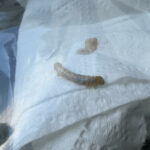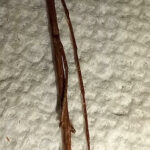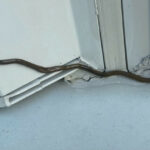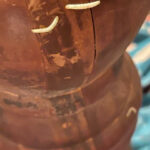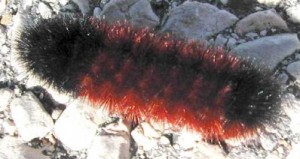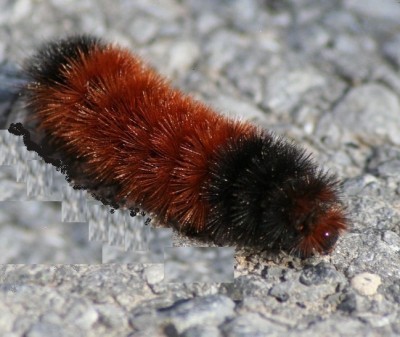
Summary: Do the stripes of woolly worms stripes predict the length or severity of winter?
It’s a long standing folk tradition that woolly worms, or woolly bears, the caterpillar of the Isabella Tiger Moth (Pyrrharctia isabella) can predict whether the coming winter will be harsh or mild.
According to the tradition, the longer the woolly bear’s black bands, the longer and more severe the winter will be, and the wider the middle brown band is indicates a milder upcoming winter. If the head end of the caterpillar is dark, the beginning of winter will be longer, darker, and harder. If the tail end is dark, the end of winter will be more severe. Alternate traditions state that if a woolly worm’s coat is thick, it will be a cold winter, or that if a that woolly bear caterpillar crawls in a southerly direction it is trying to escape the coming cold winter conditions.
The width of the brown and black bands of hairs (or setae) on the woolly worms aren’t hints of the winter to come or even the result of the previous winter. The caterpillars that go to sleep in the fall come out of hibernation and pupate in the spring. The Isabella tiger moths emerge, mate, and lay the pale yellow eggs of a second generation of caterpillars on the leaves of plants that will make good food for the larvae, like plantain, dandelion and nettles.
As the 13 body segments of a woolly worm’s body develop, the front four to five and rear two or three segments are black. The reddish-brown middle segments in between grow faster than the black ones during the four to six times the woolly worm molts. The reddish section grows during late summer and autumn, until the larvae enter dormancy for the winter. During mild autumn weather, the tawny middle band grows quite wide before the larvae enter winter dormancy. If you find a woolly worm with a wide reddish band in the fall before dormancy or when they emerge following spring, that means there was a long autumn, or growing season, for the caterpillar.
Sometimes, you’ll find an all-black woolly worm. This means that the fall was cooler, or winter came early. The caterpillar went into hibernation while the black bands were still quite wide, and the rusty red band didn’t get a chance to grow. In the arctic, the feeding (or growing) season can be so short that woolly worms overwinter two or three winters.
Whether we think it’s the width of their rusty bands of bristles that tells us February will be miserable, or the direction they’re crawling that tells us we should be heading south for the winter, the woolly worms aren’t telling us anything about the winter ahead. The late summer woolly worm’s stripes tell the story of the summer and fall before!
All About Worms is always free, always reader-supported. Your tips via CashApp, Venmo, or Paypal are appreciated! Receipts will come from ISIPP Publishing.
You might also find these guys interesting!




